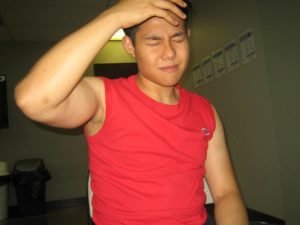A bilious headache occurs after overeating or consuming heavy meals which results to indigestion and headache. Those who have liver disorders can also suffer from this type of headache. The headache is characterized as dull pain in the forehead along with throbbing sensation in the temple.
What are the causes?
The main cause of bilious headache is overeating and indigestion. Those who do not have meals on the right time and do not stick with a healthy diet are susceptible to this type of headache.
Individuals who consume fatty, greasy and junk food face a higher risk for the headache since these foods are hard to digest and becomes a burden on the digestive system.

Indications of a bilious headache
- Throbbing and splitting pain felt in the temples
- Heaviness in the neck and head region
- Abdominal discomfort and bloating sensation
- Constipation
- Irritability and restlessness
- Regurgitation of bile from the mouth
- Feeling nauseated and often vomits large amounts of undigested food followed by bile. After an episode of vomiting, the individual feels relieved as the headache settles.
Management
The objective of treatment is to provide relief to the headache and indigestion. Once the indigestion is resolved, a bilious headache eventually settles on its own. The treatment usually includes the following:
- Application of a warm compress on the head, stomach and the bowels
- Provide the individual with warm fluids to drink
- Warm water enema can help clear constipated bowels
- A warm Sitz bath or full bath can provide relief
Preventive measures
- Certain foods must be avoided such as coffee, tea and those that contain various types of fat
- Tobacco and liquor must be avoided
- Make the necessary changes in the eating habits such as consuming small frequent meals and foods that are readily digested
- Foods that are rich in fiber such as vegetables and fruits must be included in the diet
- Exercise regularly such as brick walking for 10-15 minutes after meals or jogging in the morning.
- Make sure that the individual drinks a lot of fluids throughout the day.
